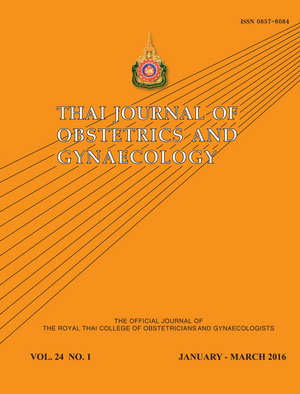Simple Clinical Maneuver for Reducing Shoulder Pain Following Gynecologic Laparoscopic Surgery at Maharat Nakhonratchasima Hospital : A randomized controlled trial
Main Article Content
Abstract
Objective: To assess the efficacy of simple clinical maneuver to reduce shoulder pain after gynecologic laparoscopic surgery.
Materials and Methods: One hundred and four patients who were scheduled for elective gynecologic laparoscopic surgery were randomly allocated to either the current standard as a control group or to additional efforts to remove residual CO2 at the end of surgery groups. For 54 patients in control group, CO2 was removed by passive deflation of the abdominal cavity through the cannula. While in 50 patients in the intervention group, CO2 was removed by means of Trendelenbrerg position (30 degrees) and a pulmonary recruitment maneuver consisting of 5 manual inflations of lung . Postoperative shoulder pain was recorded on a verbal rating scale (VRS 1-6) at 24, 48 hours after operation.
Results: There are no significant differences in age, time of surgery, type of surgery, body mass index between 2 groups except for the postoperative hospital stay (mean,SD) which are 2.5 +0.57 days in the control group compared to 2.1 + 0.47 days in the intervention group (p < 0.001). Postoperative shoulder pain (VRS 2-6) in first 48 hrs was evaluated. The significant pain is found in11 in 50 patients (22%) in the intervention group compared with34 in 54 patients (63%) in the control group (p < 0.001).
Conclusion: This simple clinical maneuver can reduce the number of patients complaining of shoulder pain after Gynecologic laparoscopic surgery with statistical significance.


